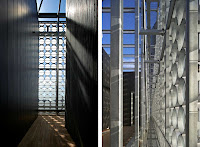The purpose of the Design Hub is to provide accommodation in one building for a diverse range of design research and post graduate education. RMIT is a world leader in design research however post graduates are currently dissipated across various campuses and facilities.
The Hub will provide a collegial research base where post graduates in fields such as fabric and fashion design will work alongside those involved in architecture, aeronautical engineering, industrial design, landscape architecture, urban design and so on.
Research groups have the ability to locate and fine tune their accommodation within ‘warehouses’ - open plan spaces where research teams can set up and tailor their work environment to suit their particular needs. Teams may stay for anywhere from six months to three years depending on the nature of and funding limits to their research and education programs.
Research may include the need for workshops to make physical models to be located alongside computer studios, three dimensional printing, virtual reality modelling and so on. Given the time frames associated with research projects all the warehouses require a high level of adaptability and flexibility.
In that sense these spaces are designed to accommodate the organic nature of research - ever evolving, adapting, changing and growing. The plan of the Hub acknowledges the desire for incidental cross pollination where researchers from one field encounter those from completely unrelated other fields as part of their day to day use of the building.
An exhibition space and design archive provide a public interface with both industry and research outcomes. These spaces combined with a variety of lecture, seminar and multi purpose rooms will facilitate high level exchanges in a number of forums. The Hub will also have the capacity to stream information from the internet and broadcast it throughout the building.
RMIT's Design Hub occupies the corner of Swanston and Victoria Streets and will be visible from the civic axis, Victoria St axis and Swanston St axis as the grid turns due north towards Carlton. The Hub will occupy one of Melbourne’s most prominent sites. Attention has been given to the provision of well designed outdoor spaces, both within and to the immediate west of the building.
The western forecourt will be flanked by a cafe, exhibition space and design archive as well providing pedestrian links to the remainder of the site which is earmarked for a variety of commercial developments. The Hub has a large number of ESD features and will incorporate strategies of water, waste and recycling management that are the equal of any ESD focussed building on the planet.
In particular the outer skin of the Hub incorporates automated sunshading that includes photovoltaic cells, evaporative cooling and fresh air intakes that improve the internal air quality and reduce running costs. The cells have been designed so that they can be easily replaced as research into solar energy results in improved technology and part of the northern façade is actually dedicated to ongoing research into solar cells to be conducted jointly by industry and RMIT.
The entire building façade, in other words, has the capacity to be upgraded as solar technology evolves and may one day generate enough electricity to run the whole building.
Location: Melbourne, Australia
Architect: Sean Godsell
Architects In Charge: Sean Godsell, Hayley Franklin
Associated Architects: Peddle Thorp Architects, Chris Godsell, James Hampton, Raf Nespola
Area: 13,000 sqm
Year: 2012
Photographs: Earl Carter














